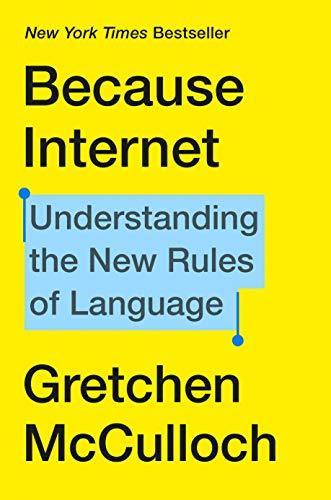Review of 'Because Internet : Understanding the New Rules of Language' on 'Goodreads'
4 stars
This is as much a guide into the world of how living with internet—and all device-interconnected glories around it—has changed language and the ways in which we think, as it is a linguistic analysis into how language has become intertwined with internet.
An example of when digital communications can be analysed:
Even keysmash, that haphazard mashing of fingers against keyboard to signal a feeling so intense that you can’t even type real words, has patterns.
A typical keysmash might look like “asdljklgafdljk” or “asdfkfjas;dfI”—quite distinct from, say, a cat walking across the keyboard, which might look like “tfgggggggggggggggggggsxdzzzzzzzz.” Here’s a few patterns we can observe in keysmash:
• Almost always begins with “a”
• Often begins with “asdf”
• Other common subsequent characters are g, h, j, k, l, and ;, but less often in that order, and often alternating or repeating within this second group
• Frequently occurring characters are the “home row” of keys that the fingers are on in rest position, suggesting that keysmashers are also touch typists
• If any characters appear beyond the middle row, top-row characters (qwe . . .) are more common than bottom-row characters (zxc . . .)
• Generally either all lowercase or all caps, and rarely contains numbers
Keysmashing may be shifting, though: I’ve noticed a second kind, which looks more like “gbghvjfbfghchc” than “asafjlskfjlskf,” from thumbs mashing against the middle of a smartphone keyboard.
If you don't think that analysis is enticing, don't worry, this book may still be for you.
McColloch writes passionately and knowingly about a lot, and she doesn't just flail away; the book is structured, and heads into matters chronologically, not only showing how people have used "internet jargon" since decades, but also (naturally) how it's evolved.
I loved reading about how romanisation works in languages like the Arabic:
Although Arabizi was initially made necessary because computers didn’t support the Arabic alphabet, it’s now taken on a social dimension. A paper by David Palfreyman and Muhamed Al Khalil, analyzing chat conversations between students at an English-speaking university in the United Arab Emirates, gave an example of a cartoon that one student drew to represent other students in her class.
One student was labeled with the name “Sheikha,” using the official Romanization of the university. But the nickname version of the same name, which doesn’t have an officially sanctioned spelling, was written in the cartoon as “shwee5”—using Arabizi “5” to represent the same sound as the official “kh.”
It’s a hand-drawn cartoon: there’s no technological reason for either name to be written in the Latin alphabet. But at least for some people, it’s become cool: participants in the study commented that “we feel that only ppl of our age could understand such symbols” and that it makes “the word sound more like ‘Arabic’ pronunciation rather than English. For example, we would type the name (‘7awla) instead of (Khawla). It sounds more Arabic this way”).”
For natural and linguistic reasons, Twitter seems to be a perfect playground to analyse internet language in our age:
Jacob Eisenstein, the linguist who was Twitter-mapping “yinz” and “hella,” and his collaborator Umashanthi Pavalanathan at Georgia Tech decided to split up English tweets in a different way. Rather than look at location, language, or script, they looked at the difference between tweets about a particular topic, say the Oscars, versus tweets in conversation with another person.
They theorized that, just as in person we’d generally talk more formally when addressing a roomful of people than when talking one on one, we’re directing a tweet with a hashtag towards a large group of people. Our @mentions, on the other hand, are more informal, only noticed by a select few—and we adjust our language electronically the same way we do out loud.
Studies of people who tweet in other languages show a similar pattern. A Dutch study of people who tweet in both the locally dominant language, Dutch, and a local minority language, Frisian or Limburgish, found that tweets with hashtags were more likely to be written in Dutch, so as to reach a broader audience, but that users would often switch to a minority language when they were replying to someone else’s tweet. The inverse was less common: few people would start in a smaller language for the hashtagged tweet and switch to the larger language for the one-on-one reply.
There's a lot of brilliant parts about stuff like trying to handle irony—about which there are some magnificent and quite unbelievable notes—typography, markup language, youth, memes, cats (of course), doge, emblem gestures, and how long somebody pauses in language before the person they're talking to thinks something starts feeling weird.
This book is colourful, brilliant training, easy-going, and its author very knowledgeable. This book is very needed, perhaps especially for Old Internet People like myself. I recommend this to all who are interested in language and who gripe too much to know that language does, thankfully, evolve; learn how or devolve.

